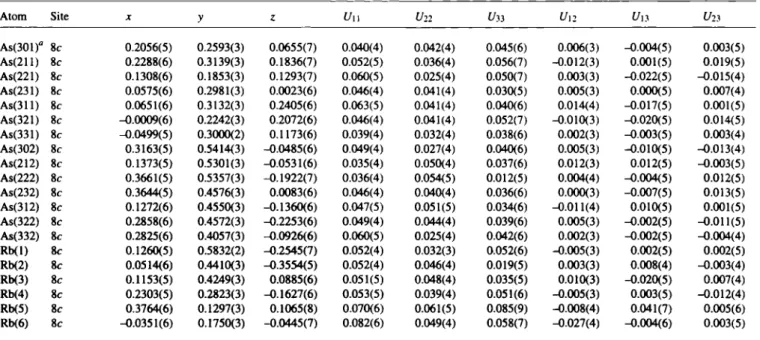Ζ. KristaMogr. NCS 217 (2002) 489-490
© by Oldenbourg Wissenschaftsverlag, München
489
Crystal structure of the low-temperature modification of trirubidium heptaarsenide, LT-Rb3As7
W. Hönle* J. Buresch", J. Wolf", K. Peters", J.-H. Chang" and H. G. von Schnering"
1 Max-Planck-Institut für Chemische Physik fester Stoffe. Nöthnitzerstr. 40, D-01187 Dresden. Germany
" Max-Planck-Institut für Festkörperforschung, Heisenbergstr. 1, D-70569 Stuttgart. Germany
Received September 17, 2002. accepted and available on-line October 17, 2002; CSD-No. 409652
AS
7(1)
As32
Source of material
Light crimson-red RbîAs7 (optical band gap 2.1 eV) is formed by reaction of stoichiometric mixtures of the elements in welded Nb-tubes (12 h up to 873 K, 36 h at 873 K, down to 293 Κ within 36 h) [ 1,2]. The transformation to HT-Rb3As7 takes place at 608 K.
The compound is very sensitive to hydrolysis and oxidation, and evaporates congruent dissociatively above 900 Κ in dynamic vacuum.
Experimental details
The relatively large residual factor reflects the poor crystal quality caused by the low transition temperature from HT to LT phase (at about 608 K). Also, the absorption correction obviously does not account for the remaining differences in the Uiy values.
Discussion
LT-Rb3As7 forms a new oPIOO structure type. The arrangement of the two crystallographically independent Zintl anions (AS7)
3-(upper and middle figures) represents a hierarchical cluster-repla- cement structure [3] of the hexagonal α-La type. For a direct com- parison, the cab setting must be chosen (in the abc setting: Ooith = Corth~/3/2 = Obex, ¿orth = Chex)· The quasi-hexagonal unit cell is emphasized by broken lines in the middle figure.
The mean As—As bond lengths and the bond angles (A=2.510 Â, Β = 2.343 Â, C = 2.387 Â, a = 101.4°, β = 99,6°, γ = 104,7°, h = 3.317 Â; lower figure) are characteristic for strongly ionic nortri- cyclenes with A > C > B , a > / ? a n d Q = h/A = 1.32Â [4,5]. The Rb
+cations connect 4 - 6 (AS7)
3-anions (<f(Rb —As) = 3.43 Â - 4.20 Â) and show the preformation of Rb3As7 molecules [5,6]
and especially (Rb2As7 - Rb - Rt>2As7)~ subunits. The first order phase transition to the plastically crystalline cubic HT-RbîAs7 [6] (hierarchical cluster-replacement LÍ3B1 structure) requires considerable rearrangements.
Table 1. Data collection and handling.
Abstract
As
7Rto
3, orthorhombic, Pbca (No. 61), a = 13.194(3) Â, b = 25.878(5) Â, c = 15.881(3) Â, V = 5422.3 À
3,Z= 16, R
gl(F)l = 0.082, wRobsfF
2) = 0.140, wR^F
2) = 0.320, T= 293 K.
Crystal:
Wavelength:
ft-
Diffractometer, scan mode:
2ö
maA·
WlWJmeasured, WlWJunique:
Criterion for Idas, N(hkl)
p: N(param)
Kfinol··
Programs:
light crimson-red polyhedron, size 0.2 χ 0.3 χ 0.3 mm Mo Ka radiation (0.71073 À) 276.90 cm!1
Siemens PI, ω 50°
4777,4777
/obs > 2 a(Iobs), 1308
182SHELXS-97 [7], SHELXL-97 [8]
ATOMS [9], DIFABS [10]
* (Correspondence author (e-mail: hoenle@cpfs.mpg.de)
490
LT-Rb3As7Table 2. Atomic coordinates and displacement parameters (in A2).
Atom Site X y ζ £Λι Un t/33 Un Un Uiì
As(301)° 8c 0.2056(5) 0.2593(3) 0.0655(7) 0.040(4) 0.042(4) 0.045(6) 0.006(3) -0.004(5) 0.003(5) As(211) 8c 0.2288(6) 0.3139(3) 0.1836(7) 0.052(5) 0.036(4) 0.056(7) -0.012(3) 0.001(5) 0.019(5) As(221) 8c 0.1308(6) 0.1853(3) 0.1293(7) 0.060(5) 0.025(4) 0.050(7) 0.003(3) -0.022(5) -0.015(4) As(231 ) 8c 0.0575(6) 0.2981(3) 0.0023(6) 0.046(4) 0.041(4) 0.030(5) 0.005(3) 0.000(5) 0.007(4) As(311) 8c 0.0651(6) 0.3132(3) 0.2405(6) 0.063(5) 0.041(4) 0.040(6) 0.014(4) -0.017(5) 0.001(5) As(321) 8c -0.0009(6) 0.2242(3) 0.2072(6) 0.046(4) 0.041(4) 0.052(7) -0.010(3) -0.020(5) 0.014(5) As(331) 8c -0.0499(5) 0.3000(2) 0.1173(6) 0.039(4) 0.032(4) 0.038(6) 0.002(3) -0.003(5) 0.003(4) As(302) 8c 0.3163(5) 0.5414(3) -0.0485(6) 0.049(4) 0.027(4) 0.040(6) 0.005(3) -0.010(5) -0.013(4) As(212) 8c 0.1373(5) 0.5301(3) -0.0531(6) 0.035(4) 0.050(4) 0.037(6) 0.012(3) 0.012(5) -0.003(5) As(222) 8c 0.3661(5) 0.5357(3) -0.1922(7) 0.036(4) 0.054(5) 0.012(5) 0.004(4) -0.004(5) 0.012(5) As(232) 8c 0.3644(5) 0.4576(3) 0.0083(6) 0.046(4) 0.040(4) 0.036(6) 0.000(3) -0.007(5) 0.013(5) As(312) 8c 0.1272(6) 0.4550(3) -0.1360(6) 0.047(5) 0.051(5) 0.034(6) -0.011(4) 0.010(5) 0.001(5) As(322) 8c 0.2858(6) 0.4572(3) -0.2253(6) 0.049(4) 0.044(4) 0.039(6) 0.005(3) -0.002(5) -0.011(5) As(332) 8c 0.2825(6) 0.4057(3) -0.0926(6) 0.060(5) 0.025(4) 0.042(6) 0.002(3) -0.002(5) -0.004(4) Rb(l) 8c 0.1260(5) 0.5832(2) -0.2545(7) 0.052(4) 0.032(3) 0.052(6) -0.005(3) 0.002(5) 0.002(5) Rb(2) 8c 0.0514(6) 0.4410(3) -0.3554(5) 0.052(4) 0.046(4) 0.019(5) 0.003(3) 0.008(4) -0.003(4) Rb(3) 8c 0.1153(5) 0.4249(3) 0.0885(6) 0.051(5) 0.048(4) 0.035(5) 0.010(3) -0.020(5) 0.007(4) Rb(4) 8c 0.2303(5) 0.2823(3) -0.1627(6) 0.053(5) 0.039(4) 0.051(6) -0.005(3) 0.003(5) -0.012(4) Rb(5) 8c 0.3764(6) 0.1297(3) 0.1065(8) 0.070(6) 0.061(5) 0.085(9) -0.008(4) 0.041(7) 0.005(6) Rb(6) 8c -0.0351(6) 0.1750(3) -0.0445(7) 0.082(6) 0.049(4) 0.058(7) -0.027(4) -0.004(6) 0.003(5)
a: labelling of the As atoms As(ijk) with ι = homoatomic connectivity,; = position in cluster (lower figure), k = number of AS7 cluster (upper figure).
References
1. Wolf, J.: Germyl- und Stannylsubstituierte Heptaarsane(3) und Undeca- arsane(3) als Reaktionsprodukte binarer Metallarsenide sowie über die neuartigen Komplexe, η -CyclooctaarsenidoniobatOOí^tNbAse]3- und cafena-Diarsasilikat i [SìAsì]2-. Dissertation, Universität Stuttgart, 1986.
2. Buresch, J.: Binäre und temäre Arsenide, Antimonide und Arsenid- Antimonide der Alkalimetalle mit den Anionen Χ3 -, X35", X4 5", i[X~], X71" und X75". Dissertation, Universität Stuttgart, 1996.
3. Canillo-Cabrera, W.; Caroca-Canales, Ν.; von Schnering, H. G.:
K2i-<sNa2+aIn39 (ó = 2.8): A cluster-replacement Clathrate-II-Structure with an Alkali Metal Mu6-Network. Ζ. Anorg. Allg. Chem. 620 (1994) 247-257.
4. Hönle, W.; von Schnering, H. G.: Die Strukturen der Hepta-Hetero- Nortricyclene P7(Sime3)3 und P4(Sime2)4· Z. Anorg. Allg. Chem. 440 (1978) 171-182.
5. von Schnering, H. G.; Hönle, W.: Bridging Chasms with Polyphosphides, Chem. Rev. 88 (1988) 243-273.
6. Hönle, W.; von Schnering, H. G., Somer, M.: Strukturen von Hepta- arseniden der Alkalimetalle und deren Solvaten. Z. Kristallogr. 174 (1986) 82-83.
7. Sheldrick, G. M.: Phase Annealing in SHELX-90: Direct Methods for Larger Structures. Acta Crystallogr. A46 (1990) 467-473.
8. Sheldrick, G. M.: SHELXL-97. Program for the Refinement of Crystal Structures. University of Göttingen, Germany 1997.
9. Dowty, E.: ATOMS 5.1. A Complete Program for Displaying Atomic Structures. By Shape software, 521 Hidden Valley Road, Kingsport, TN 37663, USA 2000.
10. Walker, N.; Stuart, D.: An Empirical Method for Correcting Diffrac- tometer Data for Absorption Effects. Acta Crystallogr. A39 (1993)
159-166.

